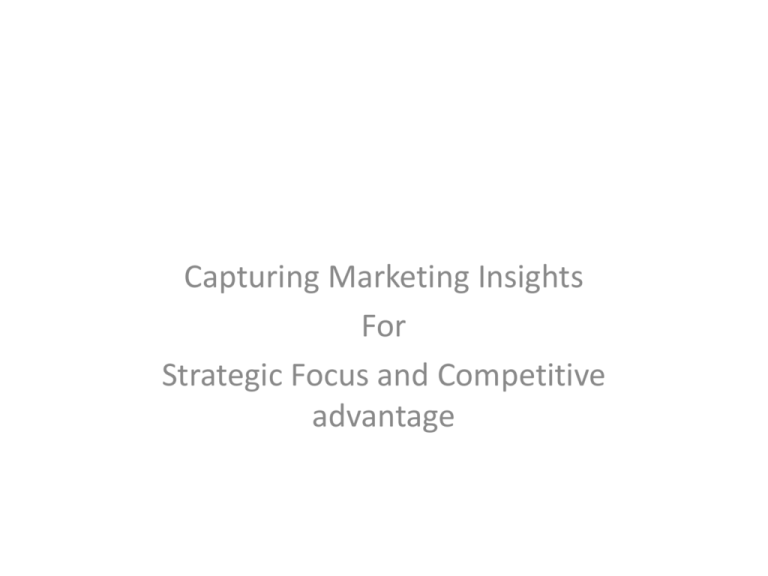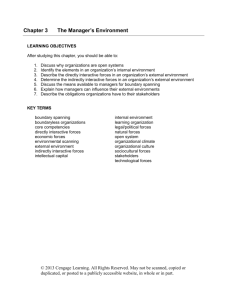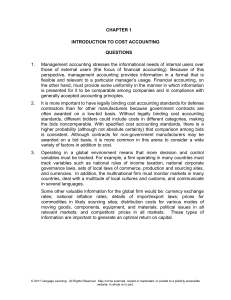
Capturing Marketing Insights
For
Strategic Focus and Competitive
advantage
Organizational Mission vs.
Organizational Vision
• Mission Statement
– Answers… “What business are we in?”
– Clear and concise
– Explains the organization’s reason for existence
• Vision Statement
– Answers… “What do we want to become?”
– Tends to be future oriented
– Represents where the organization is headed
© 2011 Cengage Learning. All Rights
Reserved. May not be scanned,
copied or duplicated, or posted to a
publicly accessible website, in whole
2
The Strategic Planning Process
© 2011 Cengage Learning. All Rights
Reserved. May not be scanned,
copied or duplicated, or posted to a
publicly accessible website, in whole
3
Organizational Aspects of the
Marketing Plan
• Top managers ask two questions:
– Will the marketing plan achieve the desired
marketing, business unit, and corporate goals and
objectives?
– Are there alternative uses of resources that would
better meet the firm’s objectives?
• The marketing plan is most often prepared by
the marketing manager, brand manager, or
product manager.
• The final approval of the marketing plan lies with
the President, Chairperson, or CEO
© 2011 Cengage Learning. All Rights
Reserved. May not be scanned,
copied or duplicated, or posted to a
publicly accessible website, in whole
4
Capturing Marketing Insights
Issues to be Considered in a
Situation Analysis
© 2011 Cengage Learning. All Rights
Reserved. May not be scanned,
copied or duplicated, or posted to a
publicly accessible website, in whole
Internal, Customer, and External
Environments
© 2011 Cengage Learning. All Rights
Reserved. May not be scanned,
copied or duplicated, or posted to a
publicly accessible website, in whole
The Customer Environment
•
•
•
•
•
Who are our Current and Potential Customers?
What do Customers do with our Products?
Where do Customers Purchase our Products?
When do Customers Purchase our Products?
Why (and How) do Customers Select our
Products?
• Why do Potential Customers not Purchase our
Products?
© 2011 Cengage Learning. All Rights
Reserved. May not be scanned,
copied or duplicated, or posted to a
publicly accessible website, in whole
The Competitive Environment
• Brand Competitors
– Market products with similar features and benefits to the
same customers at similar prices
• Product Competitors
– Compete in the same product class, but with products
that are different in features, benefits, and price
• Generic Competitors
– Market very different products that solve the same
problem or satisfy the same basic customer need
• Total Budget Competitors
– Compete for the limited financial resources of the same
customers
© 2011 Cengage Learning. All Rights
Reserved. May not be scanned,
copied or duplicated, or posted to a
publicly accessible website, in whole
The External Environment
•
•
•
•
•
Economic Growth and Stability
Political Trends
Legal and Regulatory Issues
Technological Advancements
Sociocultural Trends
– Demographic trends
– Lifestyle trends
– Trends in cultural values
© 2011 Cengage Learning. All Rights
Reserved. May not be scanned,
copied or duplicated, or posted to a
publicly accessible website, in whole
Trends in the U.S. Sociocultural
Environment
• Demographic Trends
– Aging of the American population
– Population growth in the Sun Belt states
– Increasing population diversity
• Lifestyle Trends
– Clothing becoming more casual, especially at work
– Americans have less time for leisure activities
– Increasing time spent using computers
• Trends in Cultural Values
– Shorter attention spans and less tolerance for waiting
– Less focus on “me-oriented” values
– Increasing concerns about the natural environment
© 2011 Cengage Learning. All Rights
Reserved. May not be scanned,
copied or duplicated, or posted to a
publicly accessible website, in whole
Collecting Marketing Data and
Information
• Secondary Information Sources
–
–
–
–
Internal data sources
Government sources
Book and periodical sources
Commercial sources
• Primary Data Collection
–
–
–
–
Direct observation
Focus groups
Surveys
Experiments
© 2011 Cengage Learning. All Rights
Reserved. May not be scanned,
copied or duplicated, or posted to a
publicly accessible website, in whole
Breaking Down Managerial Clichés
© 2011 Cengage Learning. All Rights
Reserved. May not be scanned,
copied or duplicated, or posted to a
publicly accessible website, in whole
Potential Issues to Consider in a
SWOT Analysis
• Strengths and Weaknesses
–
–
–
–
Presence or absence of scale and cost economies
Presence or absence of financial or human resources
Presence or absence of functional skills
Presence or absence of intellectual, legal or
reputational resources
• Opportunities and Threats
– Conditions or changes in the customer environment
– Conditions or changes in the competitive
environment
– Conditions or changes
in the external environment
© 2011 Cengage Learning. All Rights
Reserved. May not be scanned,
copied or duplicated, or posted to a
publicly accessible website, in whole
The SWOT Matrix (SWOT-driven
strategic planning)
© 2011 Cengage Learning. All Rights
Reserved. May not be scanned,
copied or duplicated, or posted to a
publicly accessible website, in whole
Establishing a Strategic Focus
• Four major directions for strategic efforts
– Aggressive (many internal strengths / many external
opportunities)
– Diversification (many internal strengths / many external
threats)
– Turnaround (many internal weaknesses / many external
opportunities)
– Defensive (many internal weaknesses / many external
threats)
• These are the most common, but other combinations
of strengths and weaknesses are possible.
© 2011 Cengage Learning. All Rights
Reserved. May not be scanned,
copied or duplicated, or posted to a
publicly accessible website, in whole
Principles of Blue Ocean Strategy
• Firms develop strategic focus by developing a
strategy that stands apart from the
competition.
• Firms can visually identify their strategic
focus through the use of the strategy canvas.
• Firms can use the Four Actions Framework to
reorient their strategic focus away from the
competition.
© 2011 Cengage Learning. All Rights
Reserved. May not be scanned,
copied or duplicated, or posted to a
publicly accessible website, in whole
Strategy Canvas
• Identifies factors that the industry currently
competes on and what customers receive from
existing product offerings (captured by the
horizontal axis)
• Identifies the offering level received by buyers
for each factor (captured by the vertical axis)
– High levels mean that a company invests more and
offers buyers more of that factor.
• Identifies a company’s relative performance
across its industry’s factors of competition
(captured by the value curve)
© 2011 Cengage Learning. All Rights
Reserved. May not be scanned,
copied or duplicated, or posted to a
publicly accessible website, in whole
Strategy Canvas for Southwest
Airlines (Exhibit 5.9)
© 2011 Cengage Learning. All Rights
Reserved. May not be scanned,
copied or duplicated, or posted to a
publicly accessible website, in whole









